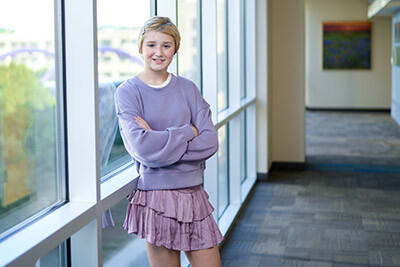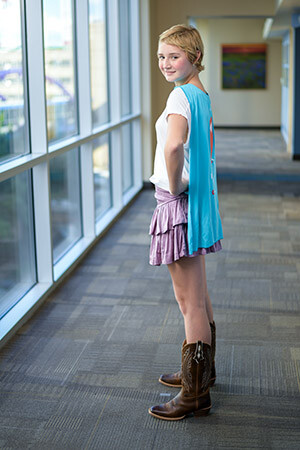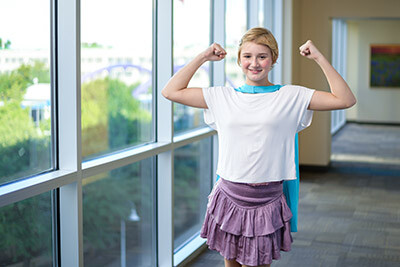
Jocelyn
A bone marrow transplant helps Jocelyn turn the corner from sickness to health
It was just before Thanksgiving 2021 and Jocelyn, a typically active tween, was huffing and puffing her way through sixth-grade PE class.

“My coach asked if I had asthma. But my mom said no,” Jocelyn said.
Alarmed, her mom, Melanie, began noticing other concerning symptoms like the odd rash up and down her daughter’s leg and an unusual level of fatigue. Melanie’s “mommy radar” continued rising while doing some online research so she made an appointment with a pediatrician near their home in Austin. The doctor assured them it was probably just a virus, but Melanie wasn’t so sure. Her online digging suggested it could be aplastic anemia.
“We were the very last appointment on the Wednesday before Thanksgiving and I could tell the doctor thought I was being an overreactive mom. But he ordered the lab work.”
The very next day – after Thanksgiving dinner but before dessert, Jocelyn notes – they got a phone call summoning them to the hospital. Melanie’s hunch, unfortunately, was spot on.
A serious form of a rare disease
Aplastic anemia is a rare but serious blood condition that occurs when the bone marrow can’t make enough new blood cells for the body to work as it should. It can develop slowly or quickly, and its impact can be mild or severe.
Jocelyn’s disease came on suddenly and intensely. Her bone marrow basically stopped producing all three types of the blood cells it typically makes: the white blood cells that fight infection; the red blood cells that carry oxygen; and the platelets that stop bleeding.
The previously energetic sixth-grader began experiencing crushing fatigue and bouts of bleeding from her gums. She required frequent transfusions to replace the blood cells her body could no longer make and was so vulnerable to infection that she had to quarantine from almost everybody.

Best care and outcomes for children in Texas
There are basically two ways to treat aplastic anemia. You can try suppressing the immune system with medicines to stop it from attacking the bone marrow, or you can try a bone marrow transplant. The family opted to try medication first, but it didn’t work. They realized she would need a bone marrow transplant – and that Austin didn’t have a pediatric transplant center. So, Melanie started doing more research.
She learned that the Pediatric Stem Cell Transplant Program at Children’s Health℠ in Dallas has the best outcomes for kids in Texas who have blood disorders like aplastic anemia and cancer. In July 2022 the family moved back to Dallas to be closer to family and to Jocelyn’s new providers. She had her transplant the following month.
Today, Jocelyn, now 13, is fully recovered and getting back to activities she had to give up while sick like volleyball and cheer.
“I feel human again,” she said. “I can do normal kid things like hang out with my friends or have a sleepover. Before I couldn’t even sit outside a restaurant because I might have caught a bad cold.”
Children’s Health cares for the whole child
Jocelyn’s road from transplant back to health wasn’t easy – she had to learn to swallow dozens of pills each day, cope with the long periods of isolation and grapple with a potentially life-threatening disease. Her mom is grateful that the top-notch team at Children’s Health approached her daughter’s care from every angle, including the physical, the social and the psychological.
“From a medical standpoint, we felt we had the best of the best at Children’s Health. The doctors and nurses were just incredible,” Melanie said, who was also wowed by the variety of therapies and support services Children’s Health offers to help patients like Jocelyn cope with illness and hospitalization.
I give props to the support services teams because those are some incredible humans, it’s horrible being stuck in a hospital 24/7 for weeks at a time, but they kept us sane through the whole process. They really know how to connect with kids and bring them out of their funk. They were always bringing Jocelyn things to do.
— Melanie, Jocelyn's mother
Music therapist Jill Pocios was one of the bright spots during the five weeks Jocelyn spent in the hospital during and after her transplant. They did art projects together because that’s what Jocelyn enjoyed. Jill even interviewed Jocelyn for the Children’s Health internal TV Channel about the pictures with inspirational messages she drew for the younger children on the transplant unit. The segment still plays every so often at the satellite campuses – and Jocelyn still enjoys the bit of fame it brings her.
Mental health: an essential part of overall health
Serious illness is hard on adolescents. They are separated from their peers. Their routines and activities are disrupted. They deal with anxiety about complex medical procedures and uncomfortable side effects from medications. They also understand far more about what they are going through than many adults realize. For Jocelyn, being able to work with Dr. Jenna Oppenheimer, one of the dedicated pediatric health psychologists in the Pauline Allen Gill Center for Cancer and Blood Disorders at Children’s Health, helped her cope with the strain of her illness and the challenges of her treatment.

“I was just not feeling it before I started working with Dr. Oppenheimer,” Jocelyn said. “I was depressed and sad. I didn’t have many friends, and whenever I saw anyone, I had to mask and social distance. I was either in the hospital or stuck at home with my parents the whole time I was sick. All I did was homework and watch movies.”
Dr. Oppenheimer saw Jocelyn every time she was hospitalized at Children’s Health and connected the family to other mental health resources throughout the health system. Jocelyn had a neuropsychiatric evaluation at Children’s Neuro Psychology and sees Dr. Preston, a psychiatrist at the Children’s Psychiatry department. Jocelyn also met with a psychiatrist who prescribed medicine. The combination of the medicine, talking about what she was experiencing, and learning some coping skills all helped. But the biggest change came when Jocelyn was well enough to return to school.
“I got to make new friends and do normal things like going to gym class and stuff,” she said.
It’s small things like this that are helping Jocelyn put the stress and uncertainty of the past two years behind her. For her family, it’s not a moment too soon.
Even though this has been the worst two years I could have imagined, I know we’ve had a pretty easy journey in terms of getting access to the care Jocelyn needed, we know how hard it could have been and we’re thankful we found everything we needed at Children’s Health.
— Melanie, Jocelyn's mother
Meet more Children's Health patients
Read more patient stories like Jocelyn's and meet our Patient Ambassadors to learn how Children's Health makes life better for children.
Kids count on us. We count on you.
Give to support innovative research, lifesaving treatments and compassionate care.
Did you enjoy this story?
If you would like to receive an email when new stories like this one are posted to our website, please complete the form below. We won't share your information, and you can unsubscribe any time.

